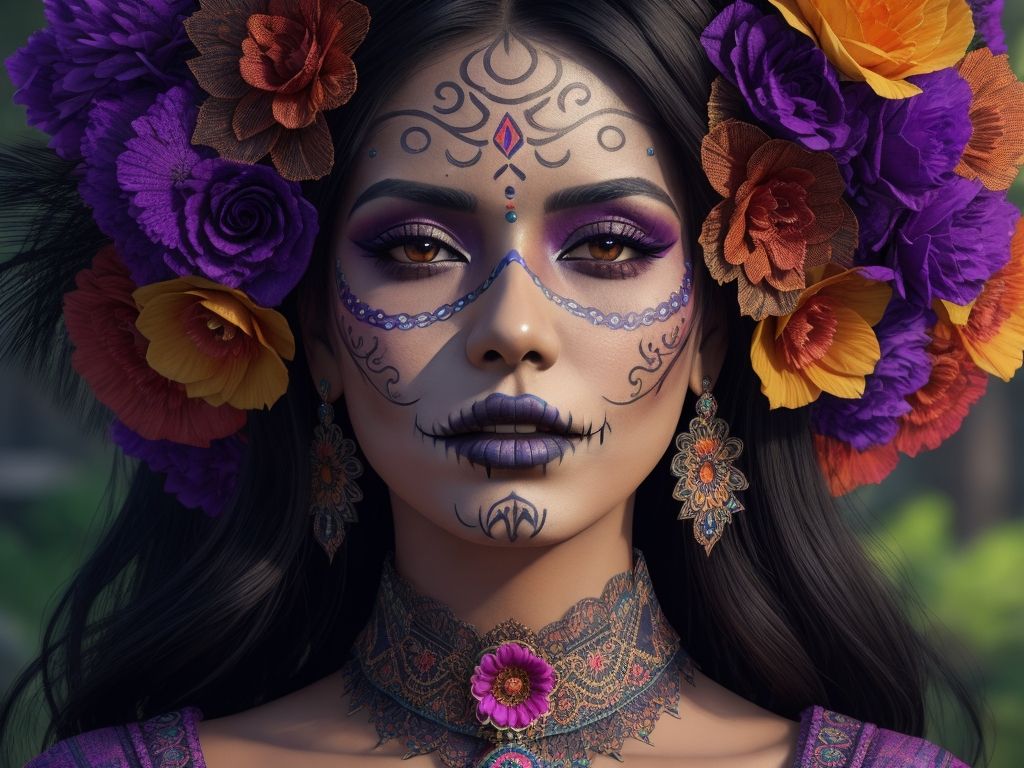Discover the profound connection between the living and the dead.
Few celebrations in the world strike as profound a chord between the living and the dead as the Day of the Dead.
Also known as Día de los Muertos.
It’s a time when people around the globe commemorate their departed loved ones in a vivid display of culture, art, and heartfelt sentiment.
What is the Day of the Dead?
The Day of the Dead is far from being a morbid occasion.
Instead, it's a joyous, vibrant festival. And it serves as a reminder of life's transience and the enduring bonds we share with those who have passed on.
Imagine yourself walking through the streets of Mexico during the Day of the Dead. The air is filled with the scent of marigolds, their bright orange petals adorning every corner. Colorful papel picado banners sway in the breeze, creating a festive atmosphere. People of all ages, dressed in traditional costumes, gather in cemeteries to honor their loved ones who have departed.
The Day of the Dead has a rich history that dates back hundreds, if not thousands, of years. You can trace back its roots to the indigenous cultures of Mexico.
Where death was treated not as an end. But as part of a larger cycle.
These ancient civilizations believed that the souls of the departed would return to visit their families during this time. To welcome them, altars were built in homes and cemeteries. Decorated with photos, favorite foods, and personal items of the deceased.
The people believed that these offerings would nourish the souls and provide them with comfort on their journey back to the spirit world.
Over time, this ancient tradition merged with Catholic customs. Most notably All Saints' Day and All Souls' Day. Leading to the birth of the Day of the Dead as we know it.

In Mexican Culture it's an important event
In Mexican culture, the Day of the Dead is a particularly significant event. It's a time for families to come together to remember those who have crossed into the afterlife. Honoring their memory, not feeling sad about their departure.
Skulls (known as calacas or calaveras) are one of the most recognizable symbols of the Day of the Dead. They're not supposed to be scary or morbid. But more like a representation of the cycle of life and death. You can find these intricately decorated skulls everywhere during the festival. From sugar skulls that are given as gifts to elaborate face paintings worn by celebrants.
Marigolds (or cempasúchil in Spanish) hold a special place in the Day of the Dead celebrations. People believe their vibrant orange color guides the spirits of the departed back to their loved ones. The flower petals create intricate paths, guiding souls on their journey from altars to gravesites.
The Day of the Dead is not only a time for remembrance. But also a celebration of life. It's a time to honor the memories of loved ones. To share stories and laughter. And to celebrate the connections that transcend death. It's a beautiful and meaningful tradition that reminds us to cherish every moment we have with those we hold dear.
How do they celebrate the Day of the Dead in Mexico?
The Day of the Dead is celebrated most exuberantly in its homeland: Mexico. Here, the decorations are vivid, the traditions deeply rooted, and the air filled with a palpable sense of emotion.
There are traditional practices and rituals
Several time-honored traditions characterize a typical Day of the Dead celebration in Mexico. Families gather in cemeteries to decorate the graves of the departed. They sing songs, tell anecdotes about the deceased, and commune in a celebratory, almost carnival-like atmosphere.
The atmosphere in the cemeteries is electric, as families come together to honor and remember their loved ones. The smell of marigolds fills the air, their vibrant orange petals creating a striking contrast against the backdrop of the graves. The sound of laughter and music resonates through the cemetery, as people share stories and memories of those who have passed.

But the celebrations don't stop at the cemetery.
Homes are often decked out with special ofrendas, or altars. Embellished with photos, candles, and mementos of the loved ones being commemorated. These altars serve as a focal point for the family to gather and pay their respects.
Each ofrenda is unique, reflecting the personality and tastes of the departed. Favorite foods, drinks, and personal belongings are placed on the altar, creating a space that feels familiar and comforting. The flickering candlelight casts a warm glow on the photographs. As if the spirits of the departed are present, joining in the festivities.
What's the role of the Ofrenda?
Food plays a significant part in the Day of the Dead celebrations. The ofrenda often features traditional dishes and sweets, and favorite meals of the departed. As an homage to their earthly tastes and pleasures.
As families gather around the ofrenda, the aroma of freshly baked Pan de Muerto (Bread of the Dead) fills the room.
This and fluffy bread, decorated with sugar and shaped like bones, is a must-have during the Day of the Dead celebrations. The rich, buttery flavor is said to lure the spirits back to join the celebrations. Making sure they're present in the earthly realm.

Another iconic offering found on the ofrenda is the sugar skull.
These intricately decorated treats are a true labor of love. Skilled artisans spend hours molding and shaping the sugar into delicate skull shapes. Using vibrant icing to bring them to life. Each sugar skull is unique, reflecting the personality and characteristics of the departed.
These sugar skulls are not only a visual delight. But they also hold deep symbolism.
They represent the fleeting nature of life. And the importance of cherishing every moment. When families place the sugar skulls on the ofrenda, it reminds them of the impermanence of existence. And the need to celebrate and honor those who have passed.
Throughout Mexico, the Day of the Dead is a time of remembrance, celebration, and connection. It's a time when the living and the departed come together, united by love and cherished memories. The vibrant decorations, heartfelt traditions, and delicious offerings make this celebration a truly unique and beautiful experience.
People celebrate the Day of the Dead globally
The Day of the Dead is deeply ingrained in Mexican culture. But did you know that it's celebrated in various forms around the globe?
Let's explore how different nations recognize this fascinating tradition:
United States: a blend of cultures
Many communities across the United States, especially those with significant Mexican-American populations, celebrate the Day of the Dead. The celebrations reflect the country's multicultural heritage. Embracing and adapting the original traditions, making it a unique multicultural affair.
Parades, art fairs, and concerts are just some of the events that commemorate the occasion. Often showcasing eye-catching Day of the Dead imagery like sugar skulls and vibrant marigolds.
Spain: All Saints' Day and All Souls' Day
In Spain, traditional Catholic holidays of All Saints' Day and All Souls' Day are with elements of the Day of the Dead. Families often visit the graves of their loved ones during this time to pay their respects. Just like the cemetery gatherings you often see in Mexico.
Philippines: The Night of the Dead
Meanwhile, the Philippines hosts the Pangangaluluwa. Its version of the Day of the Dead, known as the "Night of the Dead". It's a sight to see locals dressed in white, singing songs, and collecting alms for the departed on the eve of All Souls' Day.
Art plays a significant role in the Day of the Dead
Art encourages the celebration of life and the honoring of the deceased through color, design, and creativity. In Mexico, the streets are filled with colorful altars and decorations made of paper mache, flowers, and candles. Some examples of traditional art include:
The iconic sugar skulls
Sugar skulls are probably the most recognizable symbol associated with the Day of the Dead. Intricately decorated, these sweet treats symbolize the sweetness of life. Even during times of mourning.
Creating sugar skulls is also a communal activity. It often brings together family members in a joyous time of memory-making and bonding.
The Flowers of the Dead
The marigold holds a special place in the Day of the Dead celebrations. They're known as the "Flower of the Dead".
People believe that marigolds attract the spirits of the deceased with their vibrant colors and strong scent. And they scatter their petals to create paths that help guide spirits towards their families' homes.
Papel picado (perforated paper)
Papel picado is another important element of Day of the Dead celebrations. This colorful tissue paper is cut into elaborate designs and hung to create a festive atmosphere.
It's believed that the movement of the papel picado in the wind helps guide spirits to their altars.

Day of the Dead has even made its mark in popular culture
The Day of the Dead has such a captivating and deep appeal that it has gained a lot of interest. Even in pop culture. Films, art, music, and more continue to incorporate this rich tradition, bringing it to a wider audience.
Films and festivals celebrate the Day of the Dead
From the award-winning animation "Coco" to the James Bond film "Spectre", the Day of the Dead has been well represented in popular cinema.
Festivals around the world also include elements of this celebration. Spreading its unique flavor to a global audience. For example, the Festival of the Skeletons in Florida's Key West or the Festival of the Ancestors in London.
It influences fashion and art
Meanwhile, the distinctive Day of the Dead motifs have found their way into the world of fashion and contemporary art.
From runway trends featuring sugar skulls and marigolds to stunning works of street art, the Day of the Dead has left an indelible mark on creativity and style worldwide.
The Day of the Dead is a celebration of life
The Day of the Dead is a beautiful and vibrant celebration that honors life, death, and all those who have passed. Its customs, food, artistry, and global presence make it an awe-inspiring spectacle.
And it's a great reminder to always cherish our loved ones and celebrate their memory with joy, love, and creativity.
So, let's embrace this fascinating tradition, whether we're Mexican or not. Because in the end, it's all about coming together to honor life and death in a meaningful way.
In Mexico, death is celebrated as a part of life. And what makes the Day of the Dead truly special is its ability to unite us all in a beautiful celebration of life.
So, let's keep the tradition alive and honor our loved ones. Now and forever.





Comments ()